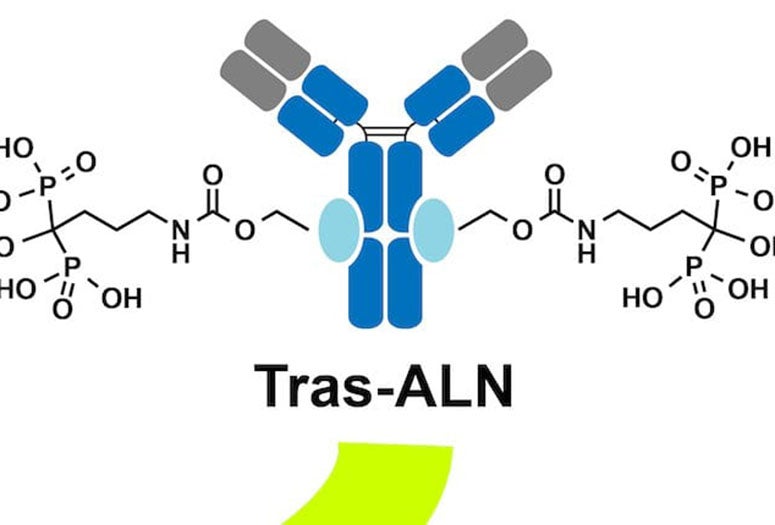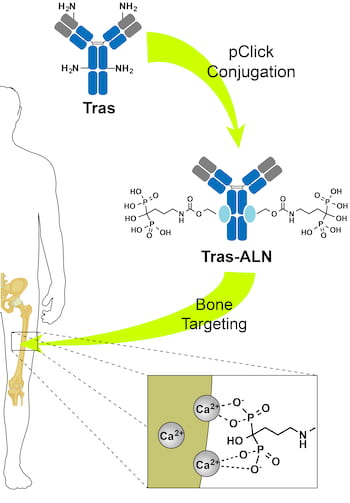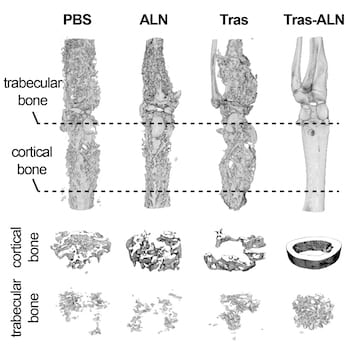HOUSTON – (June 23, 2021) – Bone cancer is hard to treat and prone to metastasis. Research teams at Rice University and Baylor College of Medicine have a new strategy to attack it.
Chemist Han Xiao at Rice and biologist Xiang Zhang at Baylor and their labs have developed an antibody conjugate called BonTarg that delivers drugs to bone tumors and inhibits metastasis.
Their open-access study, which appears in Science Advances, shows how Xiao’s pClick technology can be used to link bone-targeting antibodies and therapeutic molecules.
In experiments, they used pClick to couple a molecule used to treat osteoporosis, alendronate, with the HER2-targeting antibody trastuzumab used to treat breast cancer and found it significantly enhanced the concentration of the antibody at tumor sites.
They reported the combination also inhibited secondary metastasis from infected organs seeded by bone tumors.
“Bone cancer is really challenging to treat, and clinical trials of different treatments have been disappointing for people with bone metastasis,” said Xiao, who joined Rice in 2017 with funding from the Cancer Prevention and Research Institute of Texas (CPRIT). “We feel our strategy is a real game changer.”
“Getting effective concentrations of drugs to bone tumors has been challenging because bones are hard, their networks of blood vessels is limited and drugs have tended to attach to adjacent healthy tissues,” Zhang said.
The new strategy employs bisphosphonates, a class of drugs typically used to treat osteoporosis. Bisphosphonates have a high binding affinity for hydroxyapatite, the main component of hard bone, and help overcome physical and biological barriers in the bone microenvironment.
They’re also amenable to binding with drugs through pClick, which uses a cross-linker to snap to specific sites on antibodies without having to re-engineer them with harmful chemicals, enzymes or ultraviolet light.
The result is a molecule that seeks out bone tumors and stays put, giving the drug time to kill tumor cells. It helps that bisphosphonate molecules prefer acidic sites like bone tumors, keeping the drug concentration higher there than in surrounding healthy tissue.
The researchers chose breast cancer drugs because while many recover from the disease, 20 to 40% of breast cancer survivors eventually suffer metastases to distant organs, with metastasis to bone occurring in about 70% of these cases, significantly increasing mortality, they said.
While chemotherapy, hormone and radiation therapy used to treat women with bone metastatic breast cancers can shrink or slow bone metastasis, they usually do not eliminate the metastases, Xiao said.
“Bone is kind of a fertile soil for cancer cell,” Xiao said. “If a cancer cell reaches it, then it has a really good chance to grow and to further migrate, for example to the brain, the heart, the liver or to other tissues. That’s a really bad situation for a patient.”
Xiao hopes to get the compound into a clinical trial, and sees potential for custom conjugates that treat other tumors prone to metastasis, including prostate cancer.
Postdoctoral researchers Zeru Tian of Rice and Ling Wu of Baylor are co-lead authors of the paper. Co-authors are graduate students Chenfei Yu, Yuda Chen, Axel Loredo and Kuan-Lin Wu and postdoctoral researcher Lushun Wang of Rice; and postdoctoral fellows Zhan Xu, Igor Bado and Weijie Zhang and instructor Hai Wang of Baylor.
Xiao is the Norman Hackerman-Welch Young Investigator, the Cancer Prevention and Research Institute of Texas (CPRIT) Scholar in Cancer Research and an assistant professor of chemistry, bioengineering and biosciences. Zhang is the William T. Butler, M.D., Endowed Chair for Distinguished Faculty, McNair Scholar, associate director of the Lester and Sue Smith Breast Center, professor of molecular and cellular biology and member of the Dan L Duncan Comprehensive Cancer Center.
The research was supported by CPRIT, the National Institutes of Health, the Robert A. Welch Foundation, the U.S. Department of Defense, the John S. Dunn Foundation, the Hamill Foundation, the Breast Cancer Research Foundation and the McNair Medical Institute.
-30-
Read the abstract at https://advances.sciencemag.org/lookup/doi/10.1126/sciadv.abf2051.
Follow Rice News and Media Relations via Twitter @RiceUNews.
Related materials:
Antibodies get easy upgrade with pClick: http://news.rice.edu/2018/11/05/antibodies-get-easy-upgrade-with-pclick-2/
Rice lab turns fluorescent tags into cancer killers: http://news.rice.edu/2020/06/11/rice-lab-turns-fluorescent-tags-into-cancer-killers-2/
Xiao Lab: https://xiao.rice.edu/People/hanxiao/hanxiao.html
Xiang Zhang Lab: https://www.bcm.edu/research/labs-and-centers/faculty-labs/xiang-zhang-lab
Images for download:
https://news-network.rice.edu/news/files/2021/05/0517_BONE-1-WEB.jpg
Scientists at Rice University and Baylor College of Medicine are using pClick conjugation to create therapeutic antibodies that target bone cancers. The conjugate incorporates bisphosphonate molecules that bind to the bone hydroxyapatite matrix. (Credit: Baylor College of Medicine/Rice University)
https://news-network.rice.edu/news/files/2021/05/0517_BONE-2-WEB.jpg
MicroCT scans of rodents show those treated with the conjugate of trastuzumab and alendronate (far right), created at Rice University and Baylor College of Medicine, fared far better than those treated with phosphate-buffered saline (PBS) or alendronate (ALN) or trastuzumab (Tras) alone 82 days after tumor implantation. (Credit: Baylor College of Medicine/Rice University)
https://news-network.rice.edu/news/files/2021/05/0517_BONE-34-WEB.jpg
Xiang Zhang, left, at Baylor College of Medicine, and Han Xiao at Rice University have developed an antibody conjugate called BonTarg that delivers drugs to bone tumors and inhibits metastasis. (Credit: Rice University/Baylor College of Medicine)
Located on a 300-acre forested campus in Houston, Rice University is consistently ranked among the nation’s top 20 universities by U.S. News & World Report. Rice has highly respected schools of Architecture, Business, Continuing Studies, Engineering, Humanities, Music, Natural Sciences and Social Sciences and is home to the Baker Institute for Public Policy. With 3,978 undergraduates and 3,192 graduate students, Rice’s undergraduate student-to-faculty ratio is just under 6-to-1. Its residential college system builds close-knit communities and lifelong friendships, just one reason why Rice is ranked No. 1 for lots of race/class interaction and No. 1 for quality of life by the Princeton Review. Rice is also rated as a best value among private universities by Kiplinger’s Personal Finance.
Baylor College of Medicine (www.bcm.edu) in Houston is recognized as a health sciences university and is known for excellence in education, research and patient care. It is the only private medical school in the greater southwest and is ranked 22ndamong medical schools for research and 17th for primary care by U.S. News & World Report. Baylor is listed 20th among all U.S. medical schools for National Institutes of Health funding and No. 1 in Texas. Located in the Texas Medical Center, Baylor has affiliations with seven teaching hospitals and jointly owns and operates Baylor St. Luke’s Medical Center, part of CHI St. Luke’s Health. Currently, Baylor has more than 3,000 trainees in medical, graduate, nurse anesthesia, physician assistant, orthotics and genetic counseling as well as residents and postdoctoral fellows. Follow Baylor College of Medicine on Facebook (http://www.facebook.com/BaylorCollegeOfMedicine) and Twitter (http://twitter.com/BCMHouston).






